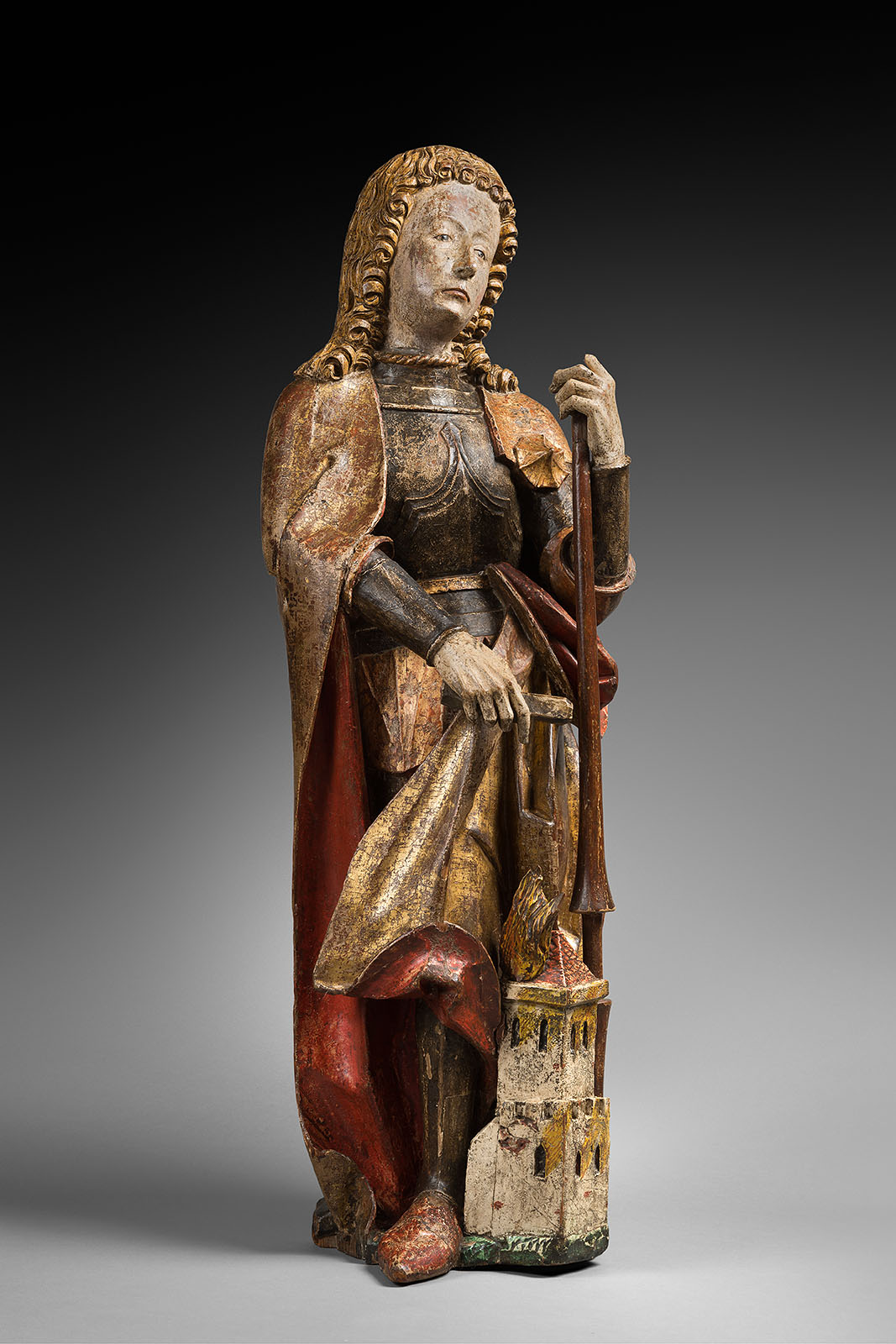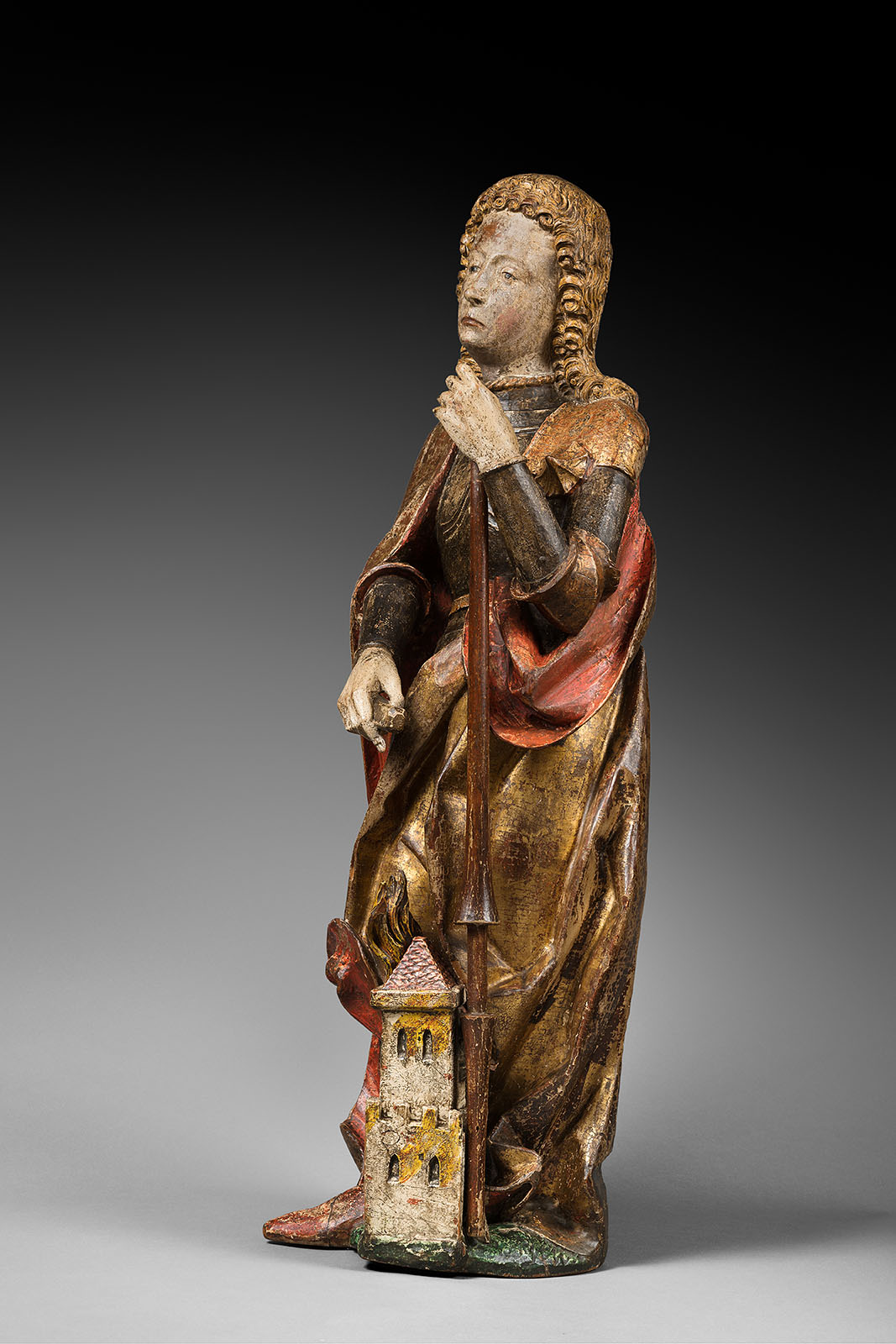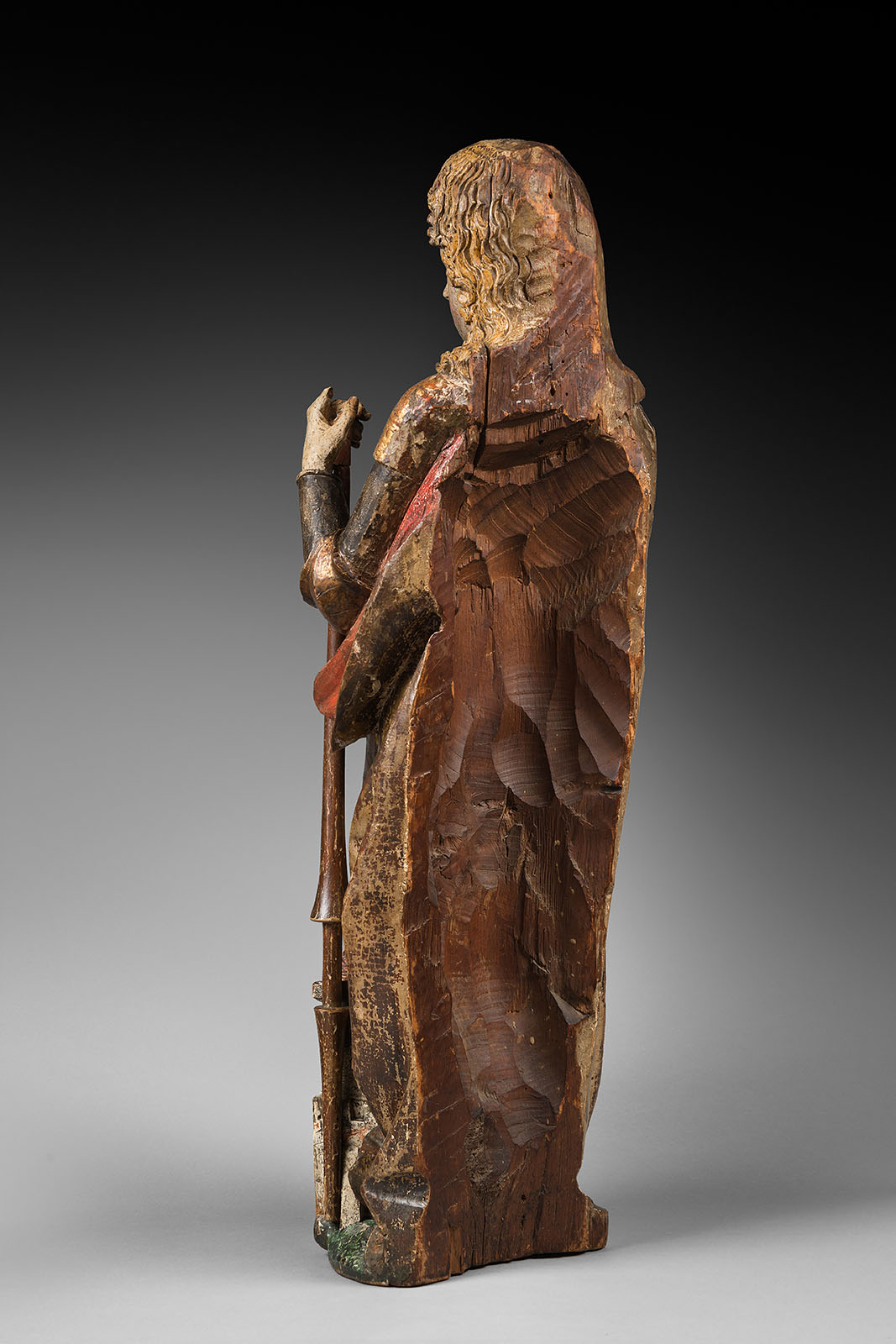Description
During the Middle-Age Saint Florian was particularly popular, subject to worship in Austria -Tyrol- Bavaria and Bohemia. Embodying courage and commitment Saint Florian was invoked to protect the soul of the living against sins and to keep the soul of the deads from the purgatory.
From the mid-15th century he safeguards from water and fire. The legend has it that when he was young the saint had contained the fire of a burning church with a simple jug of water and had saved a coal merchant from another fire.
This evolution within Saint Florian’s worship is also expressed in arts. For a long time the saint was depicted armoured, holding a sword and victorious over death. From the mid-15th century he is depicted holding a sword and watering a burning house with his jug or bucket of water.
Our sculpture belongs to this second iconographic type. Showing an elongated figure the saint is monoxyle, made from a unique limewood log. The sculpture is almost carved in the round with the back being hollowed out. The original polychromy is well preserved.
The legionary saint, standing, used to hold a bucket of water with which he sprinkled water over a burning house. In his left hand he is holding a spear. The smooth face of the juvenile saint is framed by curly shoulder-length hair.
Saint Florian wears on his shoulders a red and golden cloak over an armour. We can see the breastplate attached to the spaulders. The pieces of armour he wears on his right leg are also depicted with accuaracy.
The face of Saint Florian shows fine features. The semi closed eyelids are topped by eyebrows drown with a simple and precise black line. The gaze is heavy, expressing resignation or melancholy higlighted with a straight and petite mouth.
To the restrained face is opposed the cloak drapery carvings. The cloth is light, agitated and inflated by the wind deniying the material in which it was carved and bringing a realistic air to the sculpture.
This sculpture has to be linked, both because of its iconography and of its style, to the southern Germany production of the late 15th century. Indeed from 1475 to 1530 approximately southern Germany production is marked by a great creativity, becoming a very dynamic center. This art often described as « late gothic » is characterized by softness, restrained sensitivity and by the importance given to details and the drapes virtuosity.
The production was mostly wood carvings, and limewood was the speciality of this region. This wood is tender and light allowing a great freedom for the image carver and a beautiful polish. The sculpture, made of a unique wood log, was worked horizontally thanks to a wheel. We can see the marks of this wheel on the top of Saint Florian’s head. Some elements, more complex or difficult to reach was carved separately and fixed retrospectively to the main sculpture. That was the case for the water bucket of our sculpture. The image carvers often hollowed out the core of the log because when drying it could have caused dangerous cracks. It also participated in making the sculpture lighter.
As expressed by this depiction of Saint Florian, polichromy was a capital part of the making and was never neglicted. The use of gilded paint, typical of late Medieval period, higlight the preciosity of the sculptures. Here the polychromy gives a realistic dimension to the materials depicted as well as enhances his sanctity.
The costume’s details are characteristics of Swabian artists of the late 15th century such as Hans Multscher, active in Ulm between 1430 and 1467. His flourishing workshop influenced the following generations il all Swabia.
The martyr’s costume sharpens the dating. The armour is similar to archduke Sigismond of Tyrol’s exhibited in Vienna’s Kunsthistorisches Museum and dated from 1484. The armour’s style evolves separately from the early 16th century.
Thus, this Saint Florian was made by a talented image carver from a southern Germany’s workshop in the late 15th century.
Hagiography of Saint Florian
If we follow the story of the Passion of Saint Florian, the martyr would have taken place in 304. During those years many soldiers converted to christian faith were persecuted following orders from emperor Diocletian.
After having heard the imprisonment of forty christians in Lauriacum (today Lorch, Austria) Saint Florian went to prefect Aquilinus. He refused to recant his faith despite the prefect’s anger and violence. Aquilinus condemned Florian to be thrown into the Enns river with a heavy stone attached to his neck. When later on his dead body was washed up on the shore he was watched over by an eagle until he was burried by a pious widow named Valery.
On the presumed location of his tomb was erected in 1071 an augustinian convent – Sankt Florian city, 13km away from Linz- rebuild several times over the centuries. Inside the crypt is kept what is believed to be the heavy stone of his martyr. A pilgrimage soon occured.
The spreading of Saint Florian’s relics to Italy and Poland (of which country Saint Florian is the patron saint) allowed his worship to cross Austrian borders. However it is in Austria and southern Germany that his worship was the most significant.
Saint Florian was the first Austrian martyr and the first Austrian saint canonized.
Literature
Claude Lapaire, Sculpture sur bois du Moyen-âge, Genève : Musée d’art et d’histoire, 1986
Coll., Sculpture allemande de la fin du Moyen-âge dans les collections publiques françaises : 1400-1530, Musée du Louvre, 1991
Michael Baxandall, South German Sculpture, 1480-1530, Victoria and Albert Museum, 1974
Sophie Guillot de Suduiraut, Sculptures médiévales allemandes, conservation et restauration, La Documentation française, 1993
Sophie Guillot de Suduiraut, Dévotion et séduction, Sculptures souabes des musées de France vers 1460-1530, Somogy, 2015



